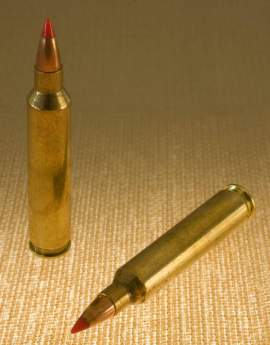
What Are The Components of Ammunition

Individuals inexperienced with firearms will mostly likely over look the complexity of what a bullet really is. The term "bullet" itself is the accepted vernacular regarding the projectile that is shot by a firearm. However, the "bullet" itself is only but a part of the actual projectile. Essentially, the way in which the term "bullet" is used day to day is a misnomer. This gives insight to the fact that ammunition is not as simple as the eye can see; there are components and parts that actually make the projectile function as it should.
The component of ammunition themselves will also vary depending of what kind of ammunition is being described. Because ammunition can refer to many types of projectiles, and not rifles, shotguns, or firearms, it is important to observe what kind of ammunition is described in order to detail how the components work for that particular type. For example the components for ammunition of a handgun will differ greatly from that of mortar, or even more so, from that a nuclear warhead.
In describing the components of ammunition, it is best to start at the simplest and most basic type. It should be noted that throughout history, ammunition has developed and changed greatly. Cannonballs and ammunition for flintlock pistols can be considered the simplest kinds of ammunition; for modernity sake, it is deemed appropriate to start with the simplest kinds of ammunition and their components for modern firearms as are used today. The simplest kind of ammunition could be regarded as the "bullets" that are currently used in rifles and handguns today.
A "bullet," or more appropriately the cartridge, is probably the most basic type of ammunition in current day. A cartridge houses the bullet itself, as well gunpowder or cordite, and primer. The casing contains the propellant and primer of the cartridge. The casing of a cartridge is often made out of copper, but steel casings are also made because of its cost-effectiveness. If viewed from a vertical cross-section, the bullet is at top, followed by the propellant and primer.
The primer housed within the rim of the cartridge, located at the lowest part of the cartridge. The primer is the small cup at the bottom of the bullet that is struck by the firearm's firing pin. A primer is typically constructed out copper or brass. The primer contains a small amount of an explosive mixture that ignites upon impact of the firing pin. The primer then acts as a catalyst to igniting the secondary or main charge, the propellant.
The propellant of a cartridge is usually made out gun powder or cordite. Cordite is more typically used in modern day because it is a smokeless propellant was developed and produced in 1889 by the United Kingdom. Gun powder was initially used for all firearms until about the 19th century, when materials such as cellulose and glycerine were developed and researchers began to find a replacement for gun powder.
The bullet of the cartridge is the actual projectile that is fired and intended to strike or penetrate a target. Bullets can be made from may different materials and designs, all having a specific purpose. Lead is probably the most common and simplest type of bullet. A jacketed lead bullet is coated with a another material such as copper, steel, and other metal allows. Some jacketed bullets have the lead core entirely coated or encased and are referred to as full metal jacket bullets. Others leave the point of the bullet exposed, which upon impact expands and is more deadly.
These bullets are referred to as soft points or hollow point bullets. Steel bullets also are made and are often coated with nylon or Teflon to allow for long storage periods. Armor-piercing bullets are a type of jacketed bullet with a core material that is comprised of a high density metal, such as steel, tungsten, or even depleted uranium. A flat tip is often designed because it is more effective in penetrating the target. Tracer bullets have a flare material encased in a hollowed-out back.
These types of bullets are used often in the military as signals or markers for establishing targets and rendevous points for an air-lifted pick-up of troops. Incendiary bullets have an explosive compound at the tip that is to ignite upon impact with the target. These are often used with the purpose of igniting fuel or other flammable resources from a distance and to cause more damage of an area. There are also bullets designed to be used in situations such as instruction, practice, or in cases when non-lethal force is to be used. Practice bullets are often made out of materials such as plastic, wax, or even wood.
Because they travel at shorter velocities, they are intended to be used in short-range situations. Non-lethal bullets are often used in riot control by law enforcement or military personnel. They are usually made out of rubber or plastic; often bean bags are also used and fall under this category. Lastly, blank bullets are used to simulate actual gun fire. These often do not even contain an actual bullet element, are used only for the intention of producing live gun action and sound.
A cartridge is only but a type of ammunition, and it is evident that it is complex in its nature. Furthermore, there also different types of cartridges, center fire and rim fire. Center fire ammunition is a cartridge that has a primer located at the center. Center fire are the ammunition types made in the United States. This type of ammunition has a firing pin strike the center fire primer to begin the first ignition process.
A rim fire cartridge differs from the center fire in that instead of the firing pin striking the center of the base of the cartridge, is strikes the rim, which contains the primer. These ammunition types are used generally by small caliber weapons, such as a .22 rifle. However, almost all semi-automatic firearms employ rimless ammunition.
The components of ammunition all work together to make a cartridge--or "bullet"--actually function. There are many chemical processes that occur within that small object that make it operate that it can be argued is just as complex as a firearm. It is quite a marvel that such a small object has so many things occurring, and yet it is one of the most lethal and deadly objects to exist.



















